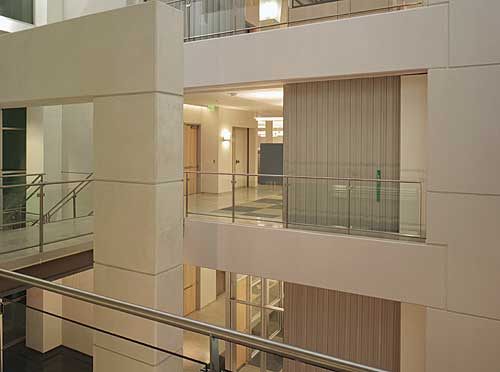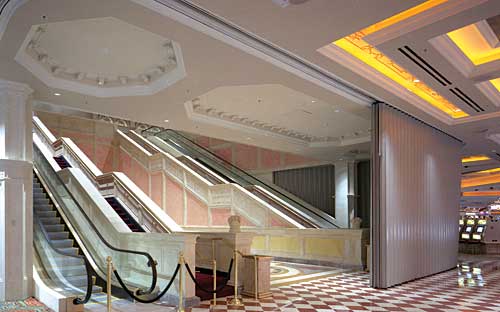Horizontal Sliding Fire Doors: Code-Compliant Design for Wide-Span Opening Protectives
The Sliding Door and Codes
The standards strictly limited the use of horizontal sliding doors.
These systems could not, for example, be the primary means of egress. Any horizontal sliding-door system that separated internal spaces also had to meet tough requirements for fire resistance. The distinction between a fixed wall and a door was that flammable objects could be stored next to a wall, but not in the way of a swinging door; moveable partitions fell into a kind of no-man's land between the two.
Horizontal sliding-door technology grew out of a desire to create a high acoustically rated folding partition which would produce sound transmission ratings comparable to insulated walls. In the early 1960s, early models were developed that used a two-track folding partition system that consisted of two walls of steel independently suspended from overhead tracks and a six-inch dead air space. While built with acoustics in mind, the horizontal sliding door was also capable of resisting fire.
In the 1970s, the horizontal sliding door passed the two major fire testing methods for door assemblies to withstand the passage of fire, holding up in intense heat rising to 1,700 degrees Fahrenheit and maintaining structural integrity. In 1986, the National Fire Protection Association committee that writes the Standard for Fire Doors and Windows first considered the introduction of a new chapter for the installation of special-purpose horizontally sliding accordion or folding doors. A few years later, the NFPA committee that writes the Means of Egress section considered a recommendation to permit the use of certain horizontal sliding doors as a means of egress in selected applications-to protect elevator lobbies, in buildings where the occupant loads were less than 50, and as fire and smoke barriers in healthcare facilities.
Sliding doors had been previously accepted for elevator lobbies, and the committee also determined that doors that slide horizontally did not present any more of a problem than swinging doors that open against the direction of travel-the latter deemed acceptable for buildings serving occupant loads of less than 50. Finally, horizontal sliding doors served as effective smoke barriers, which were required under the code for health care facilities virtually every 75 feet, to facilitate the "defend in place" approach used with occupants with special needs in fire emergencies. All of these proposed changes appeared in the 1988 edition of the Life Safety Code, and the three regional model building codes subsequently adopted them as well. The horizontal sliding door was thus acceptable as an alternative to traditional swinging doors in selected instances.
The Final Push
In 2000, the three regional building code entities merged into a single group that produced a single national uniform code-the International Building Code. Around the same time, the horizontal sliding door had a final breakthrough: an acceptable means of egress in all applications, regardless of occupancy loads, except for storage areas for flammable materials. The National Fire Protection Association changed its code as well, essentially to reflect what was in the IBC.
A chief characteristic that convinced the code writers was that the sliding-door systems could actually be easier to get through in an emergency than conventional swinging doors, while providing an effective barrier for fire and smoke, and serving as a key segregating device in other security emergencies.
|
"The burden of proof is high. The industry is reactive to cataclysmic events," said Tim Welch, vice president of business development at Won-Door, based in Salt Lake City, Utah. "We did a lot of education and showed that these systems were reliable, electronically supervised, and functioned well for egress. So over about 15 years, it's been mainstreamed. There are no restrictions on use. They can be used in any occupancy. This is all very new to enforcement professionals and design professionals."
The idea of doors not swinging for exit travel is a significant change, maybe one of the more significant changes in the building code for the last 60 years, Welch said. The change is in recognition of new technology that makes sliding-door systems ideal as both fire and smoke breaks and emergency exits, particularly for the disabled. This latter issue has been a primary concern for independent living and Universal Design advocates, because traditional swinging doors proved to be cumbersome for people in wheelchairs.
|
Universal Design is the approach to design that allows the use of the built environment by all people, regardless of age, ability or situation. It is an attempt to integrate accessibility requirements such as those under the Americans with Disabilities Act into one broad approach to make environments usable.
Emergency egress standards developed post-World War II in particular did not adequately consider the needs of the disabled. The problem was first recognized by Ed Roberts, a paraplegic appointed by then-California Governor Jerry Brown to be director of the state Department of Rehabilitation, who started thinking about how people with disabilities were supposed to escape from upper floors and buildings in general in the event of an emergency or fire. What happens if there's a power failure? People in wheelchairs obviously couldn't heed the admonition outside elevators that "in case of fire, use the stairs." Safe staging areas for emergency evacuation were needed.
Interior doors that were heavy and swung out or in posed another problem for those in wheelchairs. Getting the door open and getting through was unwieldy at best and sometimes impossible.
Sliding-door systems actually had an advantage in this regard. Manufacturers developed sensors, integrated processors, and motor technology that controlled the opening and closing of the partitions with maximum precision for any circumstance. Today's sliding-door systems can open with very little pressure, and have a manual override feature. Backup power systems are built in. In addition, a person in a wheelchair can simply make contact with an accordion-style horizontal sliding door system and it will automatically retract in an emergency. The systems also automatically stop closing if there's any obstruction, but then resume closing after a pause to maintain the integrity of the partition, similar to most elevator doors.
"A large horizontal sliding door in a fire-rated partition raises a number of questions: is it self-closing? What measures can be taken to prevent it from being blocked? What are the implications for someone trying to pass through the doorway as it is closing?" said A. Vernon Woodworth, AIA, principal in the Sullivan Code Group at the Boston-based R.W. Sullivan Engineering.
The use of electronic sensors and controls can address these concerns, Woodworth said. "This adds a new layer of complexity to building design and maintenance," he said. But, he noted, "The issue of expectations and habit are key to behavior in the built environment, and doors are for people and their use. Side-swinging doors present obstacles for people in wheelchairs whereas sliding doors do not."











